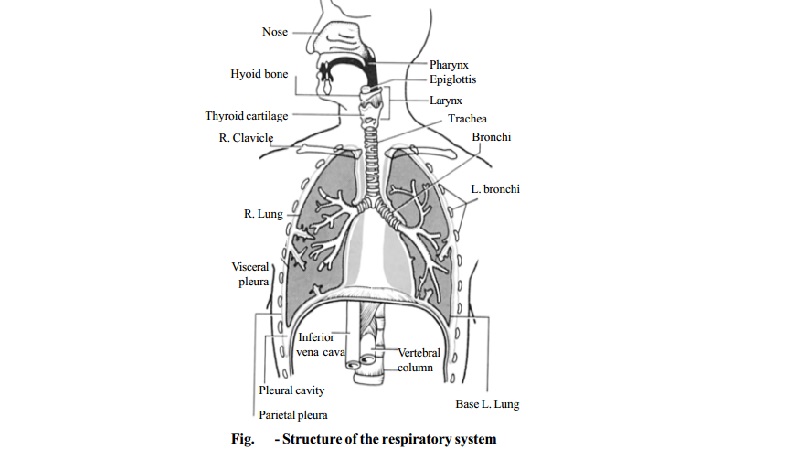Chapter: 11th 12th std standard Home Science Maintain Basic Knowledge for family life Higher secondary school College
Physiology of Respiration - Exchange of gases, Regulation, Functions, Disorders of Respiration

Physiology of Respiration
We breathe continuously from birth to death, day and night, in health and disease. Respiration may be defined as the mechanical process of breathing in and out, a function which involves both the respiratory system and the muscles of the respiration. The 2 phases of breathing are (1) Inhalation -during which the air is drawn into the lungs (2) Exhalation - which refers to the expulsion of air from the alveoli.
Inhalation
The diaphragm when relaxed is a flattened dome-shaped structure pointing upwards to the lungs. During the process of inhalation it contracts, it flattens, pulls down the thorax, increases the volume of the thorax, and thus decreases the atmospheric pressure in the lungs. This causes air to rush in during inspiration.
Exhalation
During the process of exhalation, the diaphragm relaxes, the thorax is pushed up, the volume decreases and the atmospheric pressure increases and air rushes out of the lungs.
The inspired air which contains oxygen passes down into the billions of minute air chambers or air cells known as alveoli which have very thin walls. Around these walls are the capillaries of the pulmonary system.
It is at this point that the fresh air gives off its oxygen to the blood and takes carbon-dioxide from the blood by diffusion which is then expelled with the expired air.
Exchange of gases
The interchange of gases in the lungs occurs between the blood in the capillary network surrounding the alveoli & the air in the alveoli. The total pressure exerted on the walls of the alveoli by the mixture of gases is the same as atmospheric pressure i.e. 760 mm Hg. Each gas is the mixture of gases such as O2, N2, CO2 & inert gases exert their individual partial pressures.
The partial pressure of oxygen in the alveoli is higher than deoxygenated blood in the capillaries of the pulmonary arteries. Since gases diffuse from an area of high concentration to one of lower concentration, the movement of oxygen is from alveoli to blood. For CO2 the reverse occurs. The partial pressure is higher in deoxygenated blood than in alveolar air, so CO2 passes across the walls of the capillaries and the alveoli into alveolar air.
Respiratory Rates
In adults, the respiratory rate is 14 to 18 times per minute. Children have a higher respiratory rate. Thus the respiratory rate of a new born is about 60 times per minute and that of a 6 year old child is 25 times per minute. At any age, the respiratory rate is 4.5 times lower than the heart rate. The term hyperpnoea means overbreathing due to abnormally rapid respiratory movement. Apnoea means a temporary cessation of breathing. The depth and rate of breathing are influenced by numerous factors such as emotional or mental state, changes in blood chemistry, physical fitness, metabolic rate etc., In some fevers, the respiratory rate increases in direct proportion to the increase of temperature.
Functions of Respiration
It supplies oxygen and eliminates carbondioxide.
It excretes volatile substances like ammonia, ketone bodies, essential oils, alcohol and water vapour, etc.,
By adjusting the amount of carbon-di-oxide elimination, it helps to maintain the acid base balance.
It helps to maintain the normal body temperature.
It is necessary for the maintenance of optimal oxidation-reduction process in the body.
Regulation of Respiration
The respiratory centre of the brain is located in the medulla, immediately above the spinal cord. From this centre nerve fibres extend down into the spinal cord. From the neck part of the cord, these nerve fibres continue through the phrenic nerve to the diaphragm. The diaphragm does not continue to work if it is cut off from its nerve supply. If one nerve is cut, the diaphragm of that side is paralysed. This centre is governed by variations in the chemistry of the blood. If there is an increase in CO2 in the blood, the cells of the respiratory centre are stimulated and they in turn send impulses down the phrenic nerves to the diaphragm.
Disorders
Asthma : This can occur due to hypersensitivity to foreign proteins such as dust, pollen, fungi etc. Here the bronchi constricts the airway and there is excessive secretion of sticky mucus resulting in obstruction to breathing.
Pneumonia : This occurs when microbes reach and colonise the lungs, especially streptococcus pneumoniae. It leads to fluid accumulation in the alveoli causing difficulty in breathing.
Tuberculosis : This is an infection caused by the mycobacterium species. It spreads through inhalation from air.
Related Topics